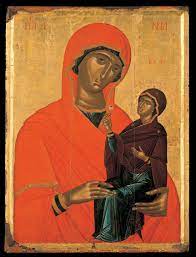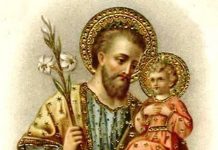St. Anne mother of Virgin Mary’s Annual Remembrance Day on July 25
Saint of the day website
تذكار القديسة حنه والدة مريم العذراء السنوي في 25 تموز
موقع قديس اليوم
وُلدت القدِّيسة حنّة في بيت لحم من سبط يهوذا. تزوَّجت حنّة بيواكيم، فاتَّحدت بزواجها ذريَّة الكهنوت بذريَّة داود. ولم يكفّ الزوجان عن التضرّع إلى الله ليُرزقا ولداً، لأنّهما كانا قد طعنا في السِّن ولم يكن لهما ولد. ولمّا تقدّم يواكيم بتقدمة إلى الهيكل، رفضها الكاهن بداعي العقريَّة. فرجع يواكيم حزينًا، باكيًا وتاه في البريّة صائمًا أربعين يوماً. وكانت حنّة مواظبة على الصّلاة. فظهر لهما ملاك الرّبّ وبشَّرهما بأنَّ الله قد قبل صلاتهما. وأنّه يرزقهما بنتاً تكون أطهر النساء وأشرفهنَّ. فنذرت حنّة أنّها تكرِّس ثمرة أحشائها لخدمة الرّبّ. ثمّ حبِلت بمريم العذراء بريئة من دنس الخطيئة الأصليّة. وبعد تسعة أشهرٍ ولدتها وأسمتها مريم، ومعنى إسم مريم سيِّدة البحر، أو المُرتفعة. وقد مدح القدِّيسة حنّة كثيرٌ من القدِّيسين، ولا سيَّما القدِّيس إبيفانيوس أسقف سلامينا في قبرص سنة 368. ومنذ ذلك الحين انتشر تكريمها هي ويواكيم في الكنيسة. وعلى اسم القدِّيسة حنّة ويواكيم كنيسة أثريّة في عنّايا تابعة لدير مار مارون، وهي الوحيدة في لبنان تُدعى بهذا الإسم. آمين!
St. Anne mother of Virgin Mary’s Annual Remembrance on July 25
Saint of the day website
St. Anne, the mother of the Virgin Mary, according to tradition derived from certain apocryphal writings. St. Anne is one of the patron saints of Brittany and Canada and of women in labour. As the grandparents of Jesus, Anne and her husband Joachim are also considered the patron saints of grandparents; their feast day is celebrated on July 26.
Information concerning her life, which startlingly parallels the Old Testament story of the barren Hannah and her conception of the prophet Samuel (1 Samuel 1), is found in the 2nd-century Protevangelium of James (“First Gospel of James”) and the 3rd-century Evangelium de nativitate Mariae (“Gospel of the Nativity of Mary”). According to these non-scriptural sources, Anne (Hebrew: Ḥannah) was born in Bethlehem in Judaea. She married Joachim, and they shared a wealthy and devout life at Nazareth. Grieved by her barrenness, Anne promised God that she would dedicate her firstborn child to the Lord’s service. The couple then received a vision of an angel, who announced that Anne would conceive and bear a most wondrous child, Mary. When the child was three years old, Joachim and Anne, in fulfillment of her divine promise, brought Mary to the Temple of Jerusalem, where they left her to be brought up.
The Protevangelium account of the life of St. Anne became the foundation for establishing the liturgical feasts of the Nativity of the Virgin Mary (September and the Immaculate Conception of the Blessed Virgin Mary (December , which is usually observed as a holy day of obligation. The dedication of Mary at the Temple became so important in church doctrine that by 1585 Pope Sixtus V included in the Western church calendar the liturgical feast of the Presentation of the Virgin Mary (November 21). Although this festival originated early in the East, probably at Jerusalem in 543, its first Western observance was recorded in England in the 11th century. Indeed, the Protevangelium long had great authority in Eastern churches, and portions of it were read during the various feasts of Mary by the Greeks, Syrians, and Copts.
In addition to the narrative of the Protevangelium, certain other traditions hold that Anne, widowed shortly after the presentation of Mary at the Temple, subsequently remarried (once or twice) and is the grandmother of one or more of the Apostles, including John and James (sons of Zebedee), Simon, Jude, and James the Less (son of Alphaeus) and also of James, “the Lord’s brother,”, depending on the source. Eastern literature on Anne, going back to the 4th century, does not follow the fantastic legends of medieval Western tradition. The mother of Mary is revered in Islam, though she is not named in the Qurʾān.
Anne’s cult was fervent in the Eastern church as early as the 4th century, and many churches, the first dating from the 6th century, were built in her honour. In the early 8th century, Pope Constantine probably introduced her devotion to Rome. Anne became extremely popular in the Middle Ages and influenced such theologians as Jean de Gerson, Konrad Wimpinar, and Johann Eck. In response to attacks on her cult by Protestant reformers, devotion to St. Anne was further promoted by post-Reformation popes. In art, depictions of the Holy Family with St. Anne were especially popular in Germany, where they first appeared in the 14th century and were widely represented in the 15th; in the 15th and 16th centuries they were also frequently depicted in Italy and Spain.






















